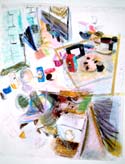ARTIST’S STATEMENT
The work you are looking at today represents an ongoing dialogue between artist and subject matter that began in the early 1980’s. Starting with “Utilitarian Iconography” whose subject matter was an ironing board and an iron and moving through the “Shelton Canal Paintings,” I have always been interested in the dailiness, the accessibility, and the pure utility of my subject matter. In the process of considering and reconsidering this seemingly mundane terrain I have found that what starts out as ordinary begins to transcend that confine -or in proclaiming its ordinariness it takes on a life of its own. Any existing hierarchical structure might be turned on its head with the least important becoming the most important and vice versa.
In many paintings I place myself on the interior side of a window looking outward, thus setting up an equation of sorts with the window as the divisor. A dialogue emerges with that which lies on the other side. As in any good dialogue there's an exchange - of information in the form of hard facts or subtle cues-and an ensuing response. I use this visual information to help me navigate and penetrate the various paths I might choose that speak best to the visual experience that I am having. In time a certain familiarity might develop between artist and subject matter. Certain liberties may be taken. A short hand of sorts may develop or a distillation of information to a “least common denominator” thus eliminating much that is unnecessary.
Most recently I have been concerning myself with issues of fragility vs. weightiness (see tissue series). I was particularly interested in describing the “structure" of a tissue while maintaining its light and gossamer qualities. In the process I became interested in emergence i.e. how does something emanate from its source. In this case the tissue from the box.
I like to think of myself as a holistic painter of sorts. By holistic I mean considering the whole. The notion of foreground would not exist if there was no backround and vice versa. I therefore consider the totality or the context as much as I do the subject matter. In the “Shelton Canal Paintings” I indeed “navigated” the terrain with brush in hand – asking myself all the while how best to express the notion of an “embankment” as it drops to contain or bolster an existing level of water. What cues might I use to express depth? And what cues to express context? The juxtaposition of the “natural” butting up against the man-made heightens any existing tension thereby showcasing the inherent strengths of each.
The process of discovery-of moving across, down and around a form truly getting to know it is a very satisfying and active part of painting. Seeing how it connects with or what its place is in reference to everything else around it and finding ways to express this is for me the essence of painting. I take nothing for granted. Following a line as it traverses through space-tight rope walking if you will-adds to the excitement of the process.
Estelle Nussbaum, July 10, 2008

